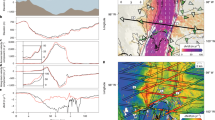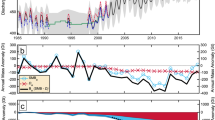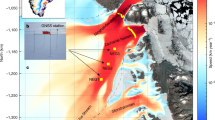Abstract
Greenland’s contribution to future sea-level rise remains uncertain and a wide range of upper and lower bounds has been proposed. These predictions depend strongly on how mass loss—which is focused at the termini of marine-terminating outlet glaciers—can penetrate inland to the ice-sheet interior. Previous studies have shown that, at regional scales, Greenland ice sheet mass loss is correlated with atmospheric and oceanic warming. However, mass loss within individual outlet glacier catchments exhibits unexplained heterogeneity, hindering our ability to project ice-sheet response to future environmental forcing. Using digital elevation model differencing, we spatially resolve the dynamic portion of surface elevation change from 1985 to present within 16 outlet glacier catchments in West Greenland, where significant heterogeneity in ice loss exists. We show that the up-glacier extent of thinning and, thus, mass loss, is limited by glacier geometry. We find that 94% of the total dynamic loss occurs between the terminus and the location where the down-glacier advective speed of a kinematic wave of thinning is at least three times larger than its diffusive speed. This empirical threshold enables the identification of glaciers that are not currently thinning but are most susceptible to future thinning in the coming decades.
This is a preview of subscription content, access via your institution
Access options
Access Nature and 54 other Nature Portfolio journals
Get Nature+, our best-value online-access subscription
$29.99 / 30 days
cancel any time
Subscribe to this journal
Receive 12 print issues and online access
$259.00 per year
only $21.58 per issue
Buy this article
- Purchase on Springer Link
- Instant access to full article PDF
Prices may be subject to local taxes which are calculated during checkout



Similar content being viewed by others
References
Wouters, B., Chambers, D. & Schrama, E. J. O. GRACE observes small-scale mass loss in Greenland. Geophys. Res. Lett. 35, L20501 (2008).
Harig, C. & Simons, F. J. Mapping Greenland’s mass loss in space and time. Proc. Natl Acad. Sci. USA 109, 19934–19937 (2012).
Schrama, E. J. O. & Wouters, B. Revisiting Greenland ice sheet mass loss observed by GRACE. J. Geophys. Res. 116, B02407 (2011).
Velicogna, I., Sutterley, T. C. & van den Broeke, M. R. Regional acceleration in ice mass loss from Greenland and Antarctica using GRACE time-variable gravity data. Geophys. Res. Lett. 41, 8130–8137 (2014).
Murray, T. et al. Extensive retreat of Greenland tidewater glaciers, 2000–2010. Arct. Antarct. Alp. Res. 47, 427–447 (2015).
Csatho, B. M. et al. Laser altimetry reveals complex pattern of Greenland ice sheet dynamics. Proc. Natl Acad. Sci. USA 111, 18478–18483 (2014).
Moon, T., Joughin, I., Smith, B. & Howat, I. 21st-century evolution of Greenland outlet glacier velocities. Science 336, 576–578 (2012).
Kjaer, K. H. et al. Aerial photographs reveal late-20th-century dynamic ice loss in northwestern Greenland. Science 337, 569–573 (2012).
Howat, I. M., Joughin, I., Fahnestock, M., Smith, B. E. & Scambos, T. A. Synchronous retreat and acceleration of southeast Greenland outlet glaciers 2000–06 ice dynamics and coupling to climate. J. Glaciol. 54, 646–660 (2008).
Bevan, S. L., Luckman, A. J. & Murray, T. Glacier dynamics over the last quarter of a century at Helheim, Kangerdlugssuaq and 14 other major Greenland outlet glaciers. Cryosphere 6, 923–937 (2012).
Khan, S. A. et al. Sustained mass loss of the northeast Greenland ice sheet triggered by regional warming. Nat. Clim. Change 4, 292–299 (2014).
Enderlin, E. M. et al. An improved mass budget for the Greenland ice sheet. Geophys. Res. Lett. 41, 866–872 (2014).
Price, S. F., Payne, A. J., Howat, I. M. & Smith, B. E. Committed sea-level rise for the next century from Greenland ice sheet dynamics during the past decade. Proc. Natl Acad. Sci. USA 108, 8978–8983 (2011).
Nick, F. M., Vieli, A., Howat, I. M. & Joughin, I. Large-scale changes in Greenland outlet glacier dynamics triggered at the terminus. Nat. Geosci. 2, 110–114 (2009).
Konrad, H. et al. Uneven onset and pace of ice-dynamical imbalance in the Amundsen Sea Embayment, West Antarctica. Geophys. Res. Lett. 44, 910–918 (2017).
Pfeffer, W. T., Harper, J. T. & O’Neel, S. Kinematic constraints on glacier contributions to 21st-century sea-level rise. Science 321, 1340–1343 (2008).
Nick, F. M. et al. Future sea-level rise from Greenland’s main outlet glaciers in a warming climate. Nature 497, 235–238 (2013).
Moore, J. C., Grinsted, A., Zwinger, T. & Jevrejeva, S. Semiempirical and process-based global sea level projections. Rev. Geophys. 51, 484–522 (2013).
Korsgaard, N. J. et al. Digital elevation model and orthophotographs of Greenland based on aerial photographs from 1978–1987. Sci. Data 3, 160032 (2016).
Morlighem, M., Rignot, E. & Willis, J. Improving bed topography mapping of Greenland glaciers using NASA’s Oceans Melting Greenland (OMG) data. Oceanography 29, 62–71 (2016).
Nye, J. F. The response of glaciers and ice-sheets to seasonal and climatic changes. Proc. R. Soc. A 256, 559–584 (1960).
Pritchard, H. D., Arthern, R. J., Vaughan, D. G. & Edwards, L. A. Extensive dynamic thinning on the margins of the Greenland and Antarctic ice sheets. Nature 461, 971–975 (2009).
Pfeffer, W. T. A simple mechanism for irreversible tidewater glacier retreat. J. Geophys. Res. 112, F03S25 (2007).
van der Veen, C. J. Greenland ice sheet response to external forcing. J. Geophys. Res. 106, 34047–34058 (2001).
Howat, I. M., Negrete, A. & Smith, B. E. The Greenland Ice Mapping Project (GIMP) land classification and surface elevation data sets. Cryosphere 8, 1509–1518 (2014).
Shean, D. E. et al. An automated open-source pipeline for mass production of digital elevation models (DEMs) from very-high-resolution commercial stereo satellite imagery. Int. Soc. Photogramm. 116, 101–117 (2016).
Rignot, E., Box, J. E., Burgess, E. & Hanna, E. Mass balance of the Greenland ice sheet from 1958 to 2007. Geophys. Res. Lett. 35, L20502 (2008).
Noël, B. et al. Evaluation of the updated regional climate model RACMO2.3: summer snowfall impact on the Greenland ice sheet. Cryosphere 9, 1831–1844 (2015).
Cuffey, K. M. & Paterson, W. S. B. The Physics of GlaciersChap. 11 (Academic, 2010).
Kamb, B. & Echelmeyer, K. A. Stress-gradient coupling in glacier flow: I. Longitudinal averaging of the influence of ice thickness and surface slope. J. Glaciol. 32, 267–284 (1986).
Acknowledgements
We would like to thank the Polar Geospatial Center for providing the WorldView stereo imagery. This work was funded by NASA Grant NNX12AP50G, by funding from the University of Texas Aerospace Engineering department, and a University of Texas Institute for Geophysics Postdoctoral Fellowship to T.C.B.
Author information
Authors and Affiliations
Contributions
D.F., T.C.B. and G.A.C. designed the study. D.F. created the WorldView DEMs, calculated catchment mass changes, and performed the kinematic wave analysis. D.F., T.C.B. and G.A.C. interpreted the results. N.J.K. and K.H.K. created the 1985 DEM. M.M. processed the mass-conserving bed for the study region. B.N. and M.v.d.B. provided downscaled SMB data. All authors discussed the results and commented on the manuscript.
Corresponding author
Ethics declarations
Competing interests
The authors declare no competing financial interests.
Supplementary information
Supplementary Information
Supplementary Information (PDF 6166 kb)
Rights and permissions
About this article
Cite this article
Felikson, D., Bartholomaus, T., Catania, G. et al. Inland thinning on the Greenland ice sheet controlled by outlet glacier geometry. Nature Geosci 10, 366–369 (2017). https://doi.org/10.1038/ngeo2934
Received:
Accepted:
Published:
Issue Date:
DOI: https://doi.org/10.1038/ngeo2934
This article is cited by
-
Short- and long-term variability of the Antarctic and Greenland ice sheets
Nature Reviews Earth & Environment (2024)
-
Atlantic water intrusion triggers rapid retreat and regime change at previously stable Greenland glacier
Nature Communications (2023)
-
Helheim Glacier ice velocity variability responds to runoff and terminus position change at different timescales
Nature Communications (2022)
-
Sediment controls dynamic behavior of a Cordilleran Ice Stream at the Last Glacial Maximum
Nature Communications (2020)
-
Interruption of two decades of Jakobshavn Isbrae acceleration and thinning as regional ocean cools
Nature Geoscience (2019)



